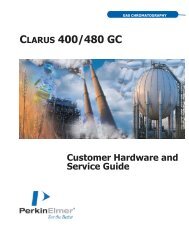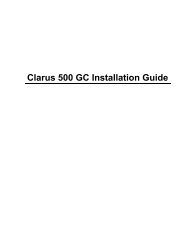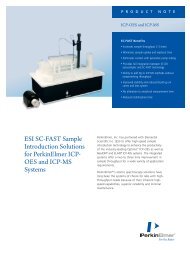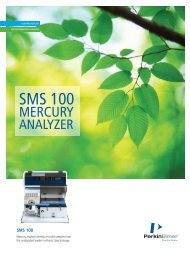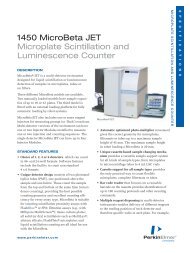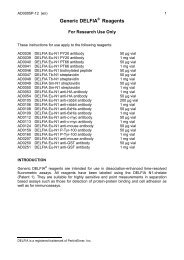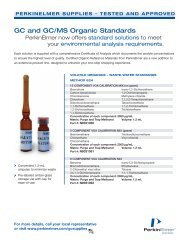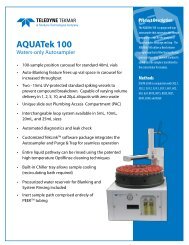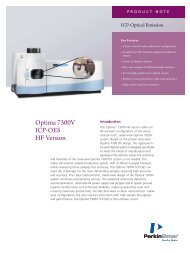HT Protein Charge Variant Kit User Guide - PerkinElmer
HT Protein Charge Variant Kit User Guide - PerkinElmer
HT Protein Charge Variant Kit User Guide - PerkinElmer
You also want an ePaper? Increase the reach of your titles
YUMPU automatically turns print PDFs into web optimized ePapers that Google loves.
<strong>HT</strong> <strong>Protein</strong> <strong>Charge</strong> <strong>Variant</strong> <strong>Kit</strong> <strong>User</strong> <strong>Guide</strong><br />
Why is the CV of the % Relative Amount greater than the specified value?<br />
Adjust the pH of the Running Buffer to confirm that the resolution is optimal. When running multiple samples of<br />
the same molecule, dilute the samples so the concentration of each differs by ±0.5 mg/mL or less, to eliminate<br />
this source of variability. Desalt samples before or after labeling to (1) remove excipients that may interfere with<br />
the profile, and (2) increase the signal.<br />
In existing data, check the Show Peak Baselines option of the Properties tab to make sure that the software<br />
analyzes each profile of the same sample in the same way (same number of peaks, with peak baselines defined<br />
at the same position within the profile). Adjust the Peak Find parameters in the Analysis Settings interface, such<br />
as the Filter Width (sec) or Slope Threshold (/sec), to improve the reproducibility of the peak find algorithm. Make<br />
sure all extraneous peaks are excluded (see Typical Results section). Also make sure that all relevant peaks are<br />
included, if summing basic and acidic variants.<br />
What are good samples to use as positive controls?<br />
Amino acids such as lysine or histidine can be used as positive control samples to make sure that the<br />
electrophoretic separation and the labeling reaction are working properly. The amino acids are labeled at a<br />
concentration of 1-10 mM. As shown in the figures below, the migration time of lysine decreases slightly with<br />
increasing Running Buffer pH. Conversely, the migration time of histidine increases significantly with increasing<br />
Running Buffer pH.<br />
Why do electropherograms change when wells from different assays are<br />
selected at the same time?<br />
If a well from the longer assay is selected first, then all data will appear in the electropherogram (including the<br />
irrelevant data of the shorter assay, collected during the sip – see Assay Performance section of FAQ). However,<br />
if a well from the shorter assay is selected first, then all data will be truncated at the total assay time of the<br />
shorter assay (68s or 90s). The additional 20 s of irrelevant data in the shorter run may include artifact peaks,<br />
particularly if the profile of the sample is near the end of the separation time (48 s or 70 s); set the end time to 48<br />
s or 70 s, for the 68s and 90s assay, respectively, to exclude these artifact peaks from the analysis. This issue<br />
will be addressed in a future software update.<br />
_________________________________________________________________________________________<br />
Caliper - a <strong>PerkinElmer</strong> Company Page 13 of 18 PN: CLS135474 Rev. 02<br />
68 Elm Street<br />
Hopkinton, MA 01748-1668<br />
1-877-LABCHIP (1-877-522-2447)



